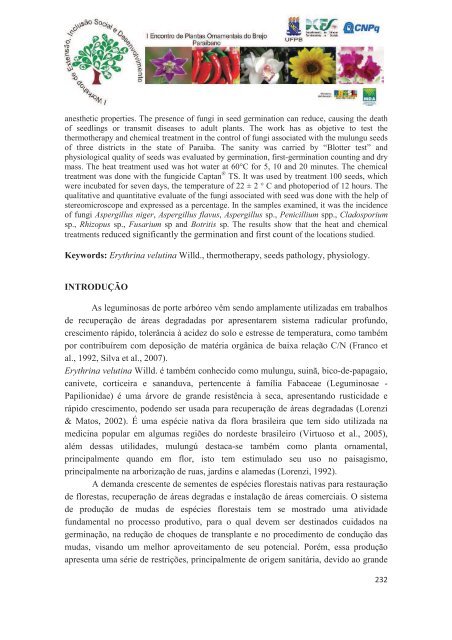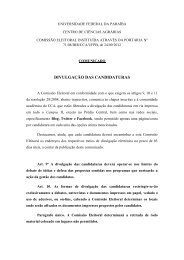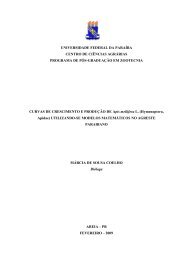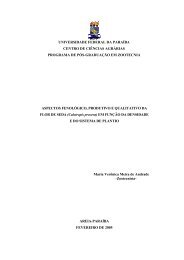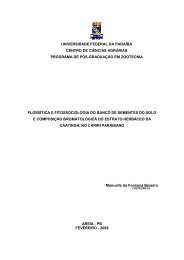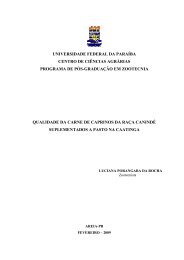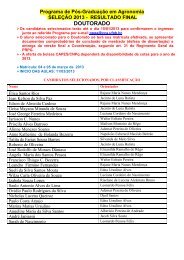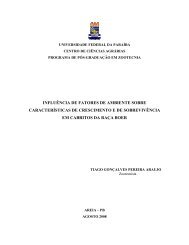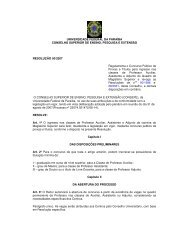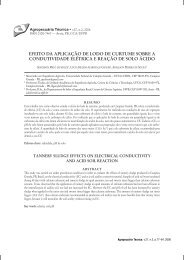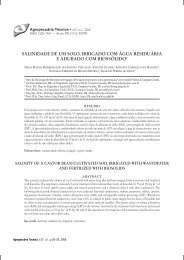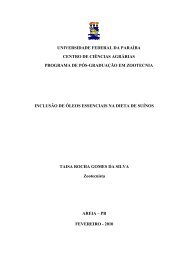- Page 2 and 3:
Realização:Apoio Financeiro:
- Page 4 and 5:
Mini-cursosMini-curso: Fisiologia e
- Page 6 and 7:
MICROPROPAGAÇÃO IN VITRO DO URUCU
- Page 8 and 9:
PRODUÇÃO DO INHAME ADUBADO COM ES
- Page 10 and 11:
portugueses, que levaram para suas
- Page 12 and 13:
De acordo com os resultados obtidos
- Page 14 and 15:
A goma de tapioca é obtida do proc
- Page 16 and 17:
possibilitado inserção social e f
- Page 18 and 19:
As Feiras Agroecológicas apresenta
- Page 20 and 21:
CARACTERIZAÇÃO AGRONÔMICA DE CUL
- Page 22 and 23:
pequeno (< 10 cm), médio (entre 10
- Page 24 and 25:
REFERÊNCIASJUNQUEIRA, A.H.; PEETZ,
- Page 26 and 27:
por exemplo, Felix & Guerra, 2000,
- Page 28 and 29:
REFERÊNCIAS BIBLIOGRÁFICASBARROS,
- Page 30 and 31:
CITOGENÉTICA DE ESPÉCIES DE Allam
- Page 32:
populações com 2n=27 e quatro, na
- Page 35 and 36:
EMERGÊNCIA DE PLÂNTULAS DE Ceiba
- Page 37 and 38:
Os dados referentes ao vigor determ
- Page 39 and 40:
ESPÉCIES DE LEGUMINOSAS ORNAMENTAI
- Page 41 and 42:
Tabela 1: Espécies de Leguminosas
- Page 43 and 44:
MICROPROPAGAÇÃO IN VITRO DO URUCU
- Page 45 and 46:
AGRADECIMENTOS: PIBIC/UFPB/CNPQREFE
- Page 47 and 48:
à subfamília Pereskioideae (Walla
- Page 49 and 50:
Dos gêneros analisados no presente
- Page 51 and 52:
NÚMEROS CROMOSSÔMICOS EM ESPÉCIE
- Page 53:
um cariótipo com 2n=22 e cromossom
- Page 56 and 57:
PERFIL DOS CONSUMIDORES AREIENSES E
- Page 58 and 59:
enda mensal, gênero e escolaridade
- Page 60 and 61:
REFERÊNCIAS BIBLIOGRÁFICASDAROLT,
- Page 62 and 63:
Dessa forma, objetiva-se avaliar o
- Page 64 and 65:
REFERÊNCIAS BIBLIOGRÁFICASANDRADE
- Page 66 and 67:
Atualmente destaca-se no cenário n
- Page 68 and 69:
Durante a realização das entrevis
- Page 70 and 71:
da ação detêm redução na suas
- Page 72 and 73:
PRODUÇÃO DE PLÂNTULAS DE GIRASSO
- Page 74 and 75:
levar a um melhor desenvolvimento d
- Page 76 and 77:
Tabela 02. Resumos da análise de v
- Page 78 and 79:
considerado uma das forças motriz
- Page 80 and 81:
o interesse pelas ciências agrári
- Page 82 and 83:
PROPAGAÇÃO IN VITRO DE VIOLETA AF
- Page 84 and 85:
temperatura ambiente; 3- sala com l
- Page 86 and 87:
TOMBOLATO, A.F.G. Cultivo comercial
- Page 88 and 89:
asileiros dessa família e na compr
- Page 90 and 91:
REFERENCIA BIBLIOGRÁFICASBELTRÃO,
- Page 92 and 93:
de polimorfismos inter e intraespec
- Page 94 and 95:
Figura 1. Metáfases mitóticas de
- Page 96 and 97:
VARIAÇÃO CROMOSSÔMICA NUMÉRICA
- Page 98 and 99:
A variação cromossômica numéric
- Page 100 and 101:
Referencia BibliográficasDONALD, C
- Page 102 and 103:
destruindo as espécies da flora, c
- Page 104 and 105:
O interesse dos agricultores pôde
- Page 106 and 107:
ABSTRACT: Ixora Conservation Postha
- Page 108 and 109:
Figura 1. Ponto de colheita comerci
- Page 110 and 111:
valor ornamental e comercial. As so
- Page 112 and 113:
quatro dias após a colheita murcha
- Page 114 and 115:
PAULL, R.F. Effect of storage durat
- Page 116 and 117:
asymmetry chromosome de 0,44 e chro
- Page 118 and 119:
contagem e identificação da morfo
- Page 120 and 121:
120
- Page 122 and 123:
Figura 3. Metáfases Mitóticas e c
- Page 124 and 125:
LORENZI, H.; SOUZA, H. M. Plantas o
- Page 126 and 127:
DIFERENTES NÍVEIS DE REPOSIÇÃO D
- Page 128 and 129:
lugar na CEASA de Campinas, quinto
- Page 130 and 131:
vaso do experimento, com plástico
- Page 132 and 133:
Larcher (1986) afirma que, pela def
- Page 134 and 135:
as plantas em condições de 100% R
- Page 136 and 137:
TABELAS E FIGURASTabela 01. Caracte
- Page 138 and 139:
45 DAT45 DATAltura de planta4030201
- Page 140 and 141:
604540% de reposição hídricaY =
- Page 142 and 143:
NASCIMENTO, J. T.; PEDROSA, M. B.;
- Page 144 and 145:
EMERGÊNCIA E VIGOR DE PLÂNTULAS D
- Page 146 and 147:
poucas informações na literatura.
- Page 148 and 149:
RESULTADOS E DISCUSSÃOO sucesso na
- Page 150 and 151:
de plântulas de Zizyphus joazeiro
- Page 152 and 153:
GUEDES, R.S.; ALVES, E.U.; GONÇALV
- Page 154 and 155:
EMERGÊNCIA E VIGOR DE PLÂNTULAS D
- Page 156 and 157:
Conforme Carneiro (1995), a semeadu
- Page 158 and 159:
Sendo assim, verifica-se que a melh
- Page 160 and 161:
posição do hilo voltado para baix
- Page 162 and 163:
BRUM, E.S.; MATTEI, V.L. Emergênci
- Page 164 and 165:
armazenamento, substrato, envelheci
- Page 166 and 167:
paraibano, bem como procurar meios
- Page 168 and 169:
mais esse desnível da utilização
- Page 170 and 171:
Figura 1 - Aulas práticas no Labor
- Page 172 and 173:
de 2º. Grau das cidades visitadas,
- Page 174 and 175:
futuramente ingressarem no mercado
- Page 176 and 177:
tecnologia catalisa mudanças não
- Page 178 and 179:
LEVANTAMENTO DAS ESPÉCIES ORNAMENT
- Page 180 and 181:
compra de tais produtos, os quais a
- Page 182 and 183: estágio) já adulto. As pessoas as
- Page 184 and 185: da cooperativa esta espécie requer
- Page 186 and 187: Iris da praiaApresenta nome cientif
- Page 188 and 189: Pingo de ouroTambém conhecida vulg
- Page 190 and 191: PRODUÇÃO DO INHAME ADUBADO COM ES
- Page 192 and 193: produção e melhoria das condiçõ
- Page 194 and 195: irrigações pelo sistema de aspers
- Page 196 and 197: 18,9, 21 e 18 t ha -1 , respectivam
- Page 198 and 199: quando comparados a outros adubos o
- Page 200 and 201: SANTOS, ACV. Biofertilizante líqui
- Page 202 and 203: variables. The seed mycoflora was c
- Page 204 and 205: Índice de velocidade de germinaç
- Page 206 and 207: Delineamento experimental e anális
- Page 208 and 209: Gurinhém e Boa Vista foram, respec
- Page 210 and 211: TABELA 4. Resumo da análise de var
- Page 214 and 215: REFERÊNCIAS BIBLIOGRÁFICASAGUIAR,
- Page 216 and 217: IBAMA. 1992. Flora: lista oficial d
- Page 218 and 219: SILVA, L. M. M.; RODRIGUES, T. J. D
- Page 220 and 221: parameters were analyzed: germinati
- Page 222 and 223: MATERIAL E MÉTODOSA pesquisa foi c
- Page 224 and 225: oplantmax®. De acordo com Figlioli
- Page 226 and 227: primeira contagem da espécie Pelto
- Page 228 and 229: BRASIL. Portaria n.006/92-N, de 15
- Page 230 and 231: RAMOS, M.B.P.; VARELA, V.P. Efeito
- Page 234 and 235: tratamentos e dispostos aleatoriame
- Page 236 and 237: Os gêneros Aspergillus flavus, Bot
- Page 238 and 239: Tabela 1. Percentagem de fungos ass
- Page 240 and 241: COUTINHO, W.M.; SILVA-MANN, R.; VIE
- Page 242 and 243: VIRTUOSO, S.; DAVET, A.; DIAS, J.F.
- Page 244 and 245: INTRODUÇÃOO gênero Capsicum, per
- Page 246 and 247: planta. Quanto maior a proporção
- Page 248 and 249: finalidade, na fase de crescimento
- Page 250 and 251: Em trabalhos desenvolvidos no centr
- Page 252 and 253: 1. INTRODUÇÃOA cultura de tecidos
- Page 254 and 255: 4. TÉCNICAS BÁSICAS4.1. Cultura d
- Page 256 and 257: parte crítica da micropropagação
- Page 258 and 259: 1. INTRODUÇÃOAs florestas vêm se
- Page 260 and 261: - Sementes Recalcitrantes: São aqu
- Page 262 and 263: 2.4. Métodos de Coleta de Sementes
- Page 264 and 265: finas exigem cuidados especiais. Po
- Page 266 and 267: depender da escolha correta do ambi
- Page 268 and 269: GALVÃO, A. P. M. (Org.) Refloresta
- Page 270 and 271: 1. INTRODUÇÃOO desequilíbrio amb
- Page 272 and 273: - Viveiros Florestais Permanentes o
- Page 274 and 275: 3.1. Dimensionamento de um ViveiroE
- Page 276 and 277: suspensão deve ser feita por tijol
- Page 278 and 279: presença de substâncias orgânica
- Page 280 and 281: 6.1 Semeadura em Canteiros para Pos
- Page 282 and 283:
WORKSHOP DE EXTENSÃO, INCLUSÃO SO
- Page 284 and 285:
metodologia é o de ajudar-nos a co
- Page 286 and 287:
Diante desta necessidade, surgiram
- Page 288 and 289:
Flexibilidade - Não existe um esqu
- Page 290 and 291:
da população nas análises das in
- Page 292 and 293:
- Diagrama de Venn (jogo das bolas)
- Page 294 and 295:
I WORKSHOP DE EXTENSÃO, INCLUSÃO
- Page 296 and 297:
em menor escala que as flores de av
- Page 298 and 299:
que ocorrem nas flores destacam-se
- Page 300 and 301:
Estas substâncias podem ser utiliz
- Page 302 and 303:
Neste mesmo trabalho, Finger et al.
- Page 304 and 305:
senescência da orquídea Phalaenop
- Page 306 and 307:
7. REFERÊNCIAS BIBLIOGRÁFICASABEL


